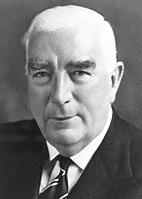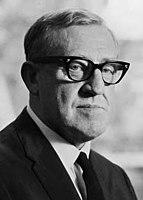| ||||||||||||||||||||||||||||||||||
All 122 seats of the House of Representatives 62 seats were needed for a majority in the House 31 (of the 60) seats of the Senate | ||||||||||||||||||||||||||||||||||
|---|---|---|---|---|---|---|---|---|---|---|---|---|---|---|---|---|---|---|---|---|---|---|---|---|---|---|---|---|---|---|---|---|---|---|
| ||||||||||||||||||||||||||||||||||
 Popular vote by state with graphs indicating the number of seats won. As this is an IRV election, seat totals are not determined by popular vote by state but instead via results in each electorate. | ||||||||||||||||||||||||||||||||||
| ||||||||||||||||||||||||||||||||||
The 1961 Australian federal election was held in Australia on 9 December 1961. All 122 seats in the House of Representatives and 31 of the 60 seats in the Senate were up for election. The incumbent Liberal–Country coalition led by Prime Minister Robert Menzies defeated the opposition Labor Party under Arthur Calwell, despite losing the two-party-preferred popular vote. In his first election as Labor leader, Calwell significantly reduced the Coalition's margin, gaining 15 seats to leave the government with only a one-seat majority. This was the first and only time the Liberal Party or any political party won a 6th successive election.
Future opposition leader and Governor General Bill Hayden entered parliament at this election.
Issues
Due to a credit squeeze, the economy had gone into a brief recession in 1961 and unemployment had risen to high levels. This saw an increase in popularity for Labor; Menzies' case was not helped by an approach seen by the press, notably the Sydney Morning Herald, as inappropriately paternalistic. The Herald, which had long supported Menzies, switched sides to support Calwell and Labor, which gave Calwell the confidence to mount a spirited campaign. These factors were enough to see a swing against the Menzies Government.
Results
House of Representatives
| Party | Votes | % | Swing | Seats | Change | ||
|---|---|---|---|---|---|---|---|
| Labor | 2,512,929 | 47.90 | +5.09 | 60 | +15 | ||
| Liberal–Country coalition | 2,208,213 | 42.09 | –4.46 | 62 | –15 | ||
| Liberal | 1,761,738 | 33.58 | –3.65 | 45 | –13 | ||
| Country | 446,475 | 8.51 | –0.81 | 17 | –2 | ||
| Democratic Labor | 399,475 | 7.61 | –0.19 | 0 | 0 | ||
| Queensland Labor | 57,487 | 1.10 | –0.50 | 0 | 0 | ||
| Communist | 25,429 | 0.48 | –0.05 | 0 | 0 | ||
| Commonwealth Centre | 6,743 | 0.13 | +0.13 | 0 | 0 | ||
| Independents | 35,757 | 0.68 | +0.05 | 0 | 0 | ||
| Total | 5,246,033 | 122 | |||||
| Two-party-preferred (estimated) | |||||||
| Liberal–Country coalition | WIN | 49.50 | –4.60 | 62 | –15 | ||
| Labor | 50.50 | +4.60 | 60 | +15 | |||
Senate
| Party | Votes | % | Swing | Seats Won | Seats Held | Change | ||
|---|---|---|---|---|---|---|---|---|
| Labor | 2,151,339 | 44.71 | +1.93 | 14 | 28 | +2 | ||
| Liberal–Country coalition | 2,025,078 | 42.08 | –3.12 | 16 | 30 | –2 | ||
| Liberal–Country joint ticket | 1,595,696 | 33.16 | +9.79 | 8 | * | * | ||
| Liberal (separate ticket) | 398,292 | 8.28 | –12.41 | 7 | 24 | –1 | ||
| Country (separate ticket) | 31,090 | 0.65 | –0.50 | 1 | 6 | –1 | ||
| Democratic Labor | 388,466 | 8.07 | +2.25 | 0 | 1 | –1 | ||
| Queensland Labor | 84,112 | 1.75 | +0.09 | 0 | 0 | 0 | ||
| Communist | 78,188 | 1.62 | –1.29 | 0 | 0 | 0 | ||
| Social Credit | 17,963 | 0.37 | +0.37 | 0 | 0 | 0 | ||
| Republican | 10,589 | 0.22 | +0.14 | 0 | 0 | 0 | ||
| Other | 10,029 | 0.21 | +0.21 | 0 | 0 | 0 | ||
| Independent | 46,499 | 0.97 | +0.54 | 1 | 1 | +1 | ||
| Total | 4,812,263 | 31 | 60 | |||||
- Notes
- In New South Wales, Queensland, and Victoria, the coalition parties ran a joint ticket. Of the eight senators elected on a joint ticket, five were members of the Liberal Party and three were members of the Country Party. In Western Australia, the coalition parties ran on separate tickets. In South Australia and Tasmania, only the Liberal Party ran a ticket.
- The sole independent elected was Reg Turnbull of Tasmania.
- "Other" includes 7,430 votes for "Pensioners" and 2,599 votes for the Commonwealth Centre Party.
Seats changing hands
| Seat | Pre-1961 | Swing | Post-1961 | ||||||
|---|---|---|---|---|---|---|---|---|---|
| Party | Member | Margin | Margin | Member | Party | ||||
| Bowman, Qld | Liberal | Malcolm McColm | 6.1 | 8.0 | 1.9 | Jack Comber | Labor | ||
| Canning, WA | Country | Len Hamilton | N/A | 65.7 | 15.7 | Neil McNeill | Liberal | ||
| Capricornia, Qld | Liberal | Henry Pearce | 7.7 | 10.7 | 5.0 | George Gray | Labor | ||
| Cowper, NSW | Country | Earle Page | 11.1 | 12.9 | 1.8 | Frank McGuren | Labor | ||
| Evans, NSW | Liberal | Frederick Osborne | 7.0 | 7.1 | 0.1 | James Monaghan | Labor | ||
| Griffith, Qld | Liberal | Arthur Chresby | 0.1 | 7.4 | 7.3 | Wilfred Coutts | Labor | ||
| Herbert, Qld | Liberal | John Murray | 1.5 | 3.8 | 2.3 | Ted Harding | Labor | ||
| Hume, NSW | Country | Charles Anderson | 2.1 | 3.0 | 0.9 | Arthur Fuller | Labor | ||
| Kalgoorlie, WA | Liberal | Peter Browne | 0.3 | 0.9 | 0.6 | Fred Collard | Labor | ||
| Lilley, Qld | Liberal | Bruce Wight | 11.9 | 13.2 | 1.3 | Don Cameron | Labor | ||
| Mitchell, NSW | Liberal | Roy Wheeler | 8.0 | 11.4 | 3.4 | John Armitage | Labor | ||
| Moore, WA | Liberal | Hugh Halbert | 2.9 | 4.2 | 1.3 | Hugh Leslie | Country | ||
| Oxley, Qld | Liberal | Donald Cameron | 5.9 | 9.4 | 3.5 | Bill Hayden | Labor | ||
| Petrie, Qld | Liberal | Alan Hulme | 10.5 | 11.2 | 0.7 | Reginald O'Brien | Labor | ||
| Phillip, NSW | Liberal | William Aston | 1.9 | 3.3 | 1.4 | Syd Einfeld | Labor | ||
| Stirling, WA | Liberal | Doug Cash | 0.2 | 0.5 | 0.3 | Harry Webb | Labor | ||
| Wide Bay, Qld | Country | Henry Bandidt | 4.3 | 9.5 | 5.2 | Brendan Hansen | Labor | ||
- Members in italics did not contest their seat at this election.
Significance
For a long time, the 1961 election remained the closest Federal election in Australian history, with the Coalition being reduced to a one-seat majority. The election was decided in the seats of Bruce near Melbourne and Moreton near Brisbane.
In Bruce, Labor's Keith Ewert led Liberal Billy Snedden on the first count, but on the second count more than two-thirds of the DLP's preferences flowed to Snedden, enough to give him the victory.[1]
However, the Coalition was not ensured of a sixth term in government until Jim Killen won Moreton by only 130 votes.[2] Labor actually won 62 seats, the same as the Coalition. However, without Bruce, the best Labor could hope for was a hung parliament, since two of its seats were in ACT and Northern Territory. At the time, territorial MPs had limited voting rights and were not counted for the purpose of determining who was to form government. The record for the closest election in Australia's history was eventually beaten by the 2010 election, which was a 72-72 seat draw.
The most notable casualty was Earle Page, the third-longest serving MP in Australia's history, and briefly Prime Minister. He had been the member for Cowper since 1919. Although he was 81 years old and gravely ill with lung cancer, he decided to fight his 17th general election. His Labor opponent, Frank McGuren, needed a seemingly daunting 11-point swing to win the seat, but won by a slim three-point margin on the second count. Page, who had been too sick to actively campaign, died 11 days after the election without ever knowing he had been defeated.
See also
- Candidates of the Australian federal election, 1961
- Members of the Australian House of Representatives, 1961–1963
- Members of the Australian Senate, 1962–1965
Notes
- ^ 1961 election results in Victoria from Adam Carr's election archive
- ^ Bartlett, Andrew (17 January 2007). "Sir James Killen: Moreton, Menzies and Mythology". The Bartlett Diaries. Archived from the original on 5 May 2007. Retrieved 15 May 2007.
References
- University of WA election results in Australia since 1890
- AEC 2PP vote
- Prior to 1984 the AEC did not undertake a full distribution of preferences for statistical purposes. The stored ballot papers for the 1983 election were put through this process prior to their destruction. Therefore, the figures from 1983 onwards show the actual result based on full distribution of preferences.

